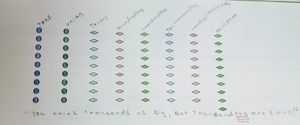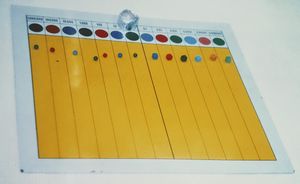Decimals Second Presentation of Quantity & Introduction of the Decimal Board and the unit as the center (Lessons 2 & 3)
From wikisori
(Redirected from Decimals Second Presentation of Quantity & Introduction of the Decimal Board and the unit as the center)
Contents
Age
9-12
Materials
- Decimal beads and disks
- a small saucer
Preparation
Students should have had the Introduction to Decimals, Lesson 1
Presentation
- 1. Place the box of decimal material on the table or presentation rug. In this presentation, we want to show the relationship between one category and another.
- 2. (This is review) Begin with one of the whole number beads-for instance, a hundred. Take out one red bead, and place it in front of the child, to his/her left. Recall that it is possible to change one hundred for ten tens. Place the hundred bead in the saucer, and take out ten blue beads, arranging them in a column to the right of where the hundred bead was (exchanging).
- 3. (This is review) It is also possible to change one ten for ten units. Remove one ten bead, and place it in the saucer. Take out ten green beads, and place them in a column to the right of the ten beads.
- 4. It is possible to change one unit for ten tenths, since we know that a unit is made up of ten tenths. Remove one unit, placing it in the saucer; and bring out ten disks to represent tenths. Arrange them to the right of the units.
- 5. Continue with hundredths and thousandths; then continue, introducing ten-thousandths, hundred-thousandths, and millionths.
- 6. Review- "How many tenths equal one unit?" "How many ten-thousandths equal one thousandth?" And so on.
- 7. Then: "How many units equal a ten?" (10) "How many tens equal a hundred?" (10) "Therefore, how many ones equal a hundred?" (100)
"How many hundredths equal a tenth?" (10) "How many tenths equal a unit?" (10) "Therefore, how many hundredths equal a unit?" (100)
Note: You can keep on going all the way back with exchanging to the unit, but it could also be 'over kill'
INTRODUCTION OF THE DECIMAL BOARD AND THE UNIT AS THE CENTER (CROWN): A REINFORCEMENT:
Materials: Decimal beads, Teacher made paper or foil crown, Decimal Board
- 1. Take a unit bead and place it on the table or presentation rug saying, "This unit is so important that we are going to give it a crown: Place the crown at the top of the unit place on the decimal board and then place the unit bead in the unit's place on the decimal board. "In the world of Math, numeral gets a crown. Every numeral gets its name from a unit."
- 2. Ask, "What is to the left of the unit?" (tens). Place a ten bead in the ten's place on the decimal board . "What is to the right of the unit?" (tenths). Place a tenth disk in the tenth's place on the decimal board. "The ten is ten times the unit; the tenth is a tenth PART of the unit."
- 3. Ask, "What is to the left of the ten?" (hundreds). Place a hundred bead in the hundred's place on the decimal board. "What is to the right of the tenths?" (hundredths). Place a hundredths disk in the hundredth's place on the decimal board. "The hundred is one hundred times the unit; the hundredth is a hundredth PART of the unit."
- 4. Continue in this way through million and millionth.
Control Of Error
Teacher guided.
Points Of Interest
Participating with the new knowledge helps move the concrete experiences toward abstract thinking
Purpose
- To make a visual, auditory and kinesthetic impression upon the child on how whole numbers are divided into smaller units-decimals.
Variation
Students can recreate the decimal board in their Math journals.
Handouts/Attachment

